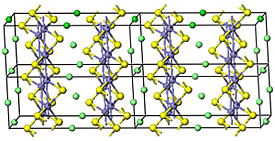Mar 25 2009
Though a year has passed since the discovery of a new family of high-temperature superconductors, a viable explanation for the iron-based materials’ unusual properties remains elusive. But a team of scientists working at the National Institute of Standards and Technology (NIST) may be close to the answer.
 NIST research shows that magnetism plays a key role in iron pnictide superconductors’ crystal structure. (Iron is purple; arsenic is yellow; calcium is green.) Only if the iron’s magnetism is taken into account do calculations of the distance between these crystal layers match up with lab measurements. Magnetism’s importance to their physical properties make it a likely factor in the iron pnictides’ ability to superconduct, say team members.
NIST research shows that magnetism plays a key role in iron pnictide superconductors’ crystal structure. (Iron is purple; arsenic is yellow; calcium is green.) Only if the iron’s magnetism is taken into account do calculations of the distance between these crystal layers match up with lab measurements. Magnetism’s importance to their physical properties make it a likely factor in the iron pnictides’ ability to superconduct, say team members.
The team has found strong evidence that magnetism is a pivotal factor governing the physical properties of iron pnictides, a group of materials that conduct electricity without resistance at temperatures of up to 56 kelvin (-217 degrees celsius). Iron pnictides are composed of regularly spaced layers of iron sandwiched between other substances. And although -217 might sound pretty cold, they are the first class of materials found to superconduct at that high a temperature since the discovery of copper-based superconductors more than two decades ago.
The team’s evidence shows that, without taking magnetism into account, theoretical calculations of iron pnictides’ inner structure do not line up with actual lab measurements. Factor in magnetism, though, and these discrepancies vanish—a decisive difference that, according to theorist Taner Yildirim, could imply that magnetism is also key to iron pnictide superconductivity.
“Without considering magnetism, for example, the calculated distance between iron layers—a distance that has been thoroughly measured—comes out to be wrong,” says Yildirim, of NIST’s Center for Neutron Research. “However, provided that we consider magnetic spin in our calculations, we can explain almost all of the iron pnictides’ structural and dynamic properties.”
Yildirim gave an invited talk* at the March meeting of the American Physical Society, where he presented theoretical evidence demonstrating how magnetism controls basic aspects of iron pnictides as the position of the atoms, the materials’ phase transition, i.e. the sudden changes in the structure with temperature, and—probably, Yildirim says—their superconducting properties.
“Determining the mechanism of superconductivity in iron pnictide systems is very important in solving the long-standing mystery of the high temperature superconductor phenomena in general,” Yildirim says. “Once we have such an understanding of this strange phenomenon, we can then make predictions and design new materials with even higher superconductivity temperatures.”